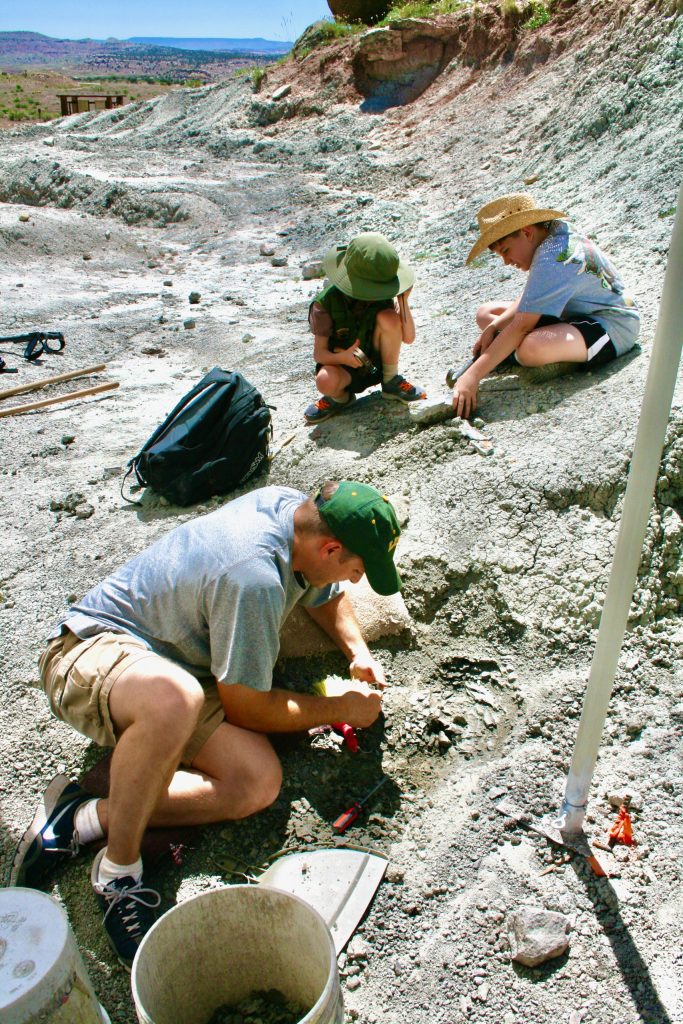
Digging for dinosaurs at Mygatt-Moore quarry in western Colorado. ©Laurel Kallenbach
Originally published November 2013
The green-and-purple tail of Triceratops disappears over the crest of the mesa, headed west through the desert toward Utah on I-70 with our van driver in hot pursuit. I sit shotgun in the van, and behind me a seat full of hyper-excited kids shouts, “Catch up, catch up!” Bouncing around in a back seat behind them is my adult brother, David Kallenbach.
Heavily loaded with children and their parents, our passenger van chugs up the Colorado mesa, and we again spot the four-wheeled Triceratops—a.k.a. The Dino Mobile, which is piloted by ace paleontologist John Foster, who leads our caravan to the Mygatt-Moore Quarry in Utah for a day-long Dino Dig. The Dino Mobile, which is decked out with three horns and the trademark bony head-frill of Triceratops, emits occasional bursts of fossil fuel from its tailpipe.
The paleontology excavation, sponsored by the Museums of Western Colorado/Dinosaur Journey Museum, is wish fulfillment for the prehistoric-reptile obsessed humans in the van—including David and me.
Once upon a time, the two of us were fossil-collecting eight-year-olds who used to bicker during road trips about who was tougher: Tyrannosaurus rex or Dimetrodon.
Like these prehistoric hunters, my brother and I spent our childhood locked in titanic struggle for no reason other than preadolescent rage about family pecking order. I fantasized about being an only child with nearly as much passion as becoming a paleontologist. David wanted to take his know-it-all sister down a peg. There was hair-pulling, arm-twisting, and, yes, even biting, at which my brother was the clear champion.
But that was ancient history—almost as long ago as the 150 million years we’re traveling back in time today. David and I are going back to the Jurassic. We’ve partnered up for a brother-sister road trip with a prehistoric theme. No longer adversaries, we both agree we have more in common than not—including our love for the outdoors and for dinosaurs. So, we’ve met in Grand Junction, Colorado—he lives in Montana; I’m from Boulder—to commemorate the car-camping treks of our childhood. Luckily for us, nearby western Colorado and eastern Utah comprise some of the world’s best dinosaur country, much of which we can access via the scenic, 512-mile Dinosaur Diamond Prehistoric Byway.
Quest for Dinosaurs
As the Dino Mobile and our van pull into Mygatt-Moore Quarry, Dexter—who has just graduated from kindergarten summa cum laude—announces he’s going to unearth a dinosaur skull today. The eight-year-old inside me thinks, “No way! I’m going to find it!” After all, I’ve got more than four decades on the kid.
First, though, we paleontologists-in-training learn the ropes. Dr. Foster demonstrates how to use our tools and tells us how to spot dinosaur fossils; they’re darker than the surrounding clay. “Never remove a fossil from the ground until a paleontologist has documented where it’s located,” he says.
David and I pick a spot under the shade awning, strap on knee-pads, arrange old carpet squares to kneel on, and start digging with screwdrivers, using them to delicately lift horizontal layers of the bleached-out clay, which was once mud along an ancient river.
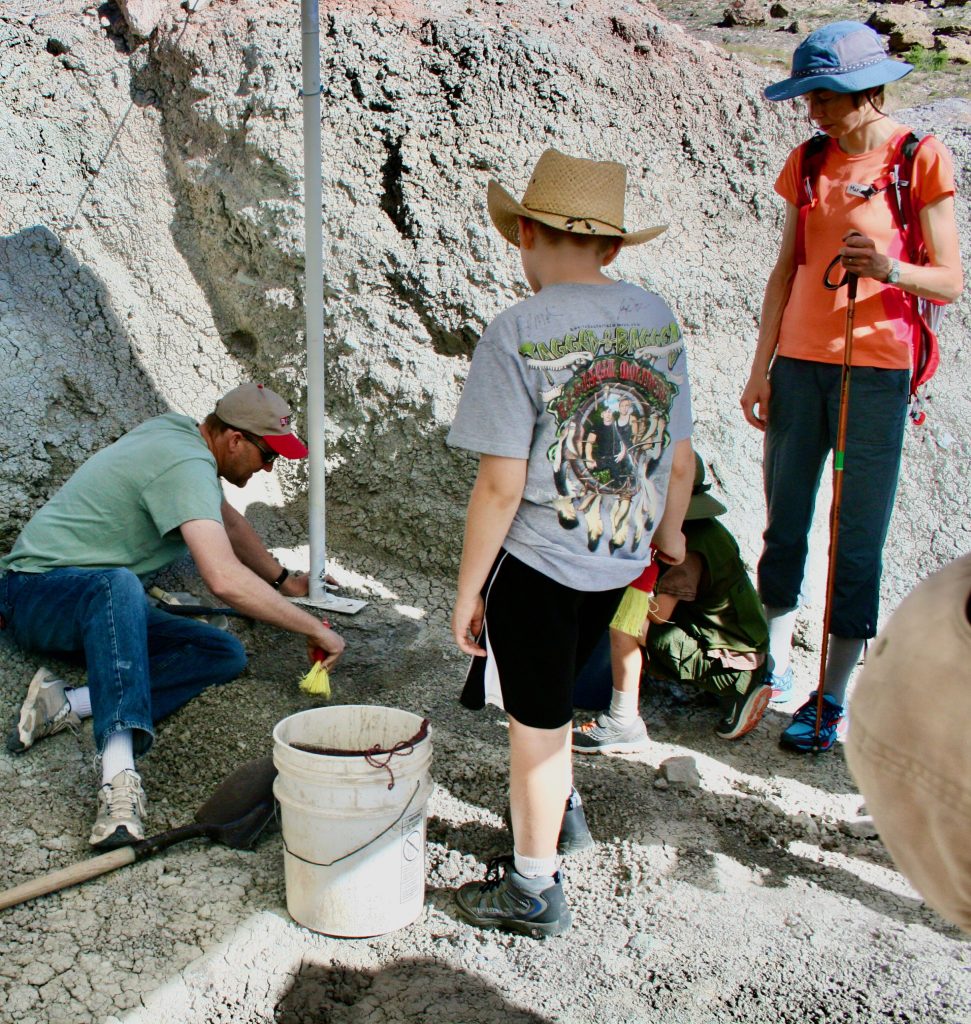
Paleontologist John Foster demonstrates how to brush away dirt at the dig. ©Laurel Kallenbach
Aw we begin digging, we scrutinize every earthen clump, sweep non-interesting pieces into a dustpan with a small paintbrush, and eventually pour the waste into a bucket. We’re hyper-vigilant for anything dark. We’ve been told that a piece of bone will have a spongy texture; dinosaur teeth are shiny black.
Fifteen minutes after we start, young Dexter calls out from his digging post nearby. “I found something!” he crows. Everyone’s heads pop up like prairie dogs on alert. Paleontology assistant Tom Temme checks, and then confirms, that Dexter has indeed unearthed a dinosaur bone fragment. David and I exchange determined looks, as if to say, We’ve been upstaged by that pipsqueak? We apply our screwdrivers to the clay with renewed fervor.
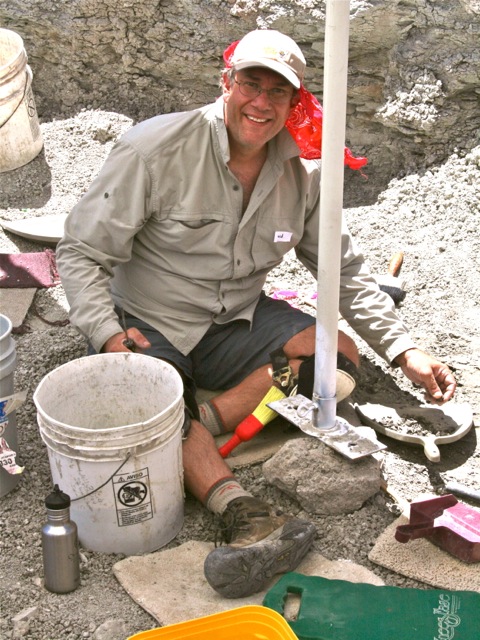
David uses the tools of the trade: screwdriver, brush, dustpan, and a bucket for hauling away empty rock. ©Laurel Kallenbach
When I encounter a blackish vein about a third-inch wide, I slow down and carefully trace its edge. Soon the vein forks to the right. My pulse pounds in my ears at the prospect of digging up the bone of an animal never before seen by humans. I call to Kelsie Abrams, a paleontology grad student who’s in Colorado for a summer of digging. She bends over my find. “Yep, that’s a stem of Equisetum—horsetail.” She touches the dark line. “You can tell because plant matter rubs off on your finger like black charcoal.” My adrenaline rush crashes.
“Equisetum grows everywhere—even today,” says David, who is a former National Park ranger and an expert on the flora and fauna of the West. “It’s pretty common.”
Pouting, I retort, “Still, it’s a 150-million-year piece of Equisetum.” But my brother and I both know that horsetail is not paleontology’s holy grail. Dinosaurs are.
We continue digging as the sun grows hotter and our legs cramp. Beside us, Frank and his ten-year-old granddaughter, Ashley, hold out a chunk of rock to Tom; there’s something dark in it. Tom carefully breaks off bits of the rock, revealing the tooth of a juvenile Allosaurus, a ferocious meat-eater. Had the tooth been from an adult, he says, it would have been three inches long. Ashley’s find—discovered just two feet to our right—ignites in us a frenzy of breaking chunks of hardened clay. The result is only sore fingers.
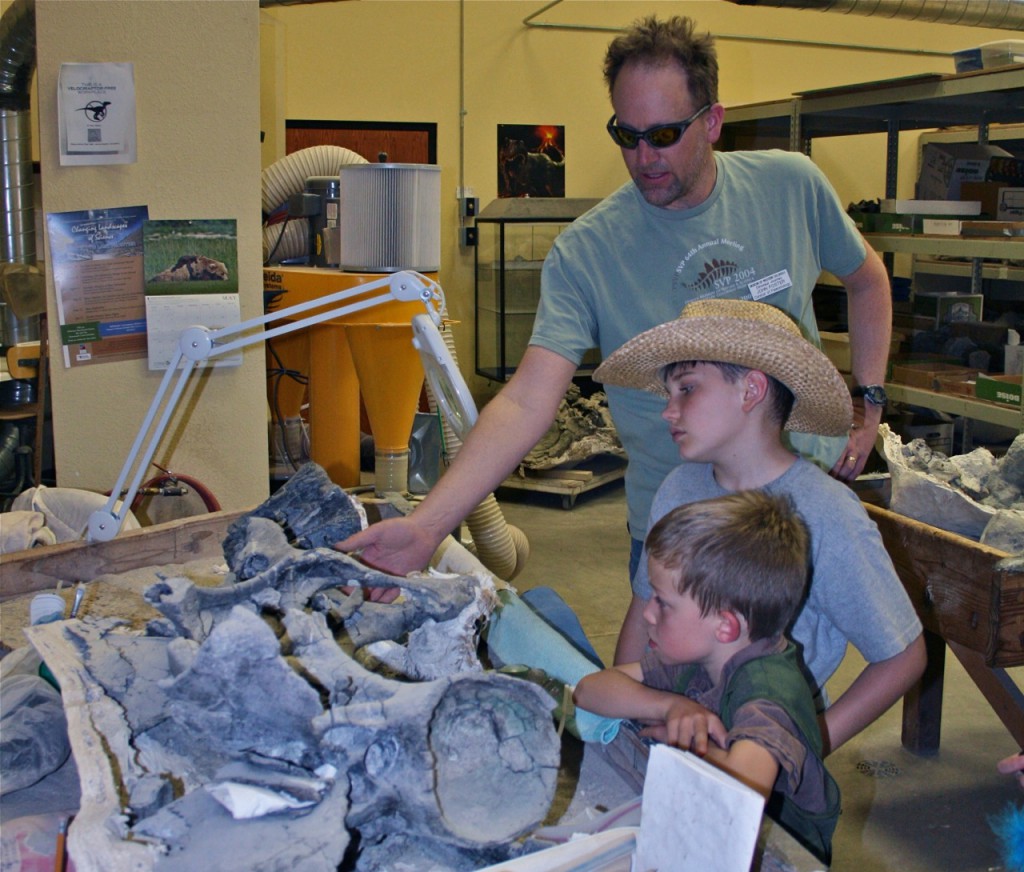
Dr. John Foster gave our group a behind-the-scenes tour of the paleontology lab to see large fossils and some of the tools scientists use to analyze them. Then my brother and I strolled through Dinosaur Journey, a family-oriented museum filled with reassembled skeletons—including our toothsome, 27-foot Allosaurus friend—and robotic recreations of dinosaurs such as the carnivorous Utahraptor and a venom-spitting Dilophosaurus. ©Laurel Kallenbach
At noon, Stephen Senior and his ten-year-old namesake unearth another piece of bone. After Tom has flagged its position in the ground, he removes it and passes it to me for a look. I have a hard time distinguishing “spongy” bone from clay. It takes a practiced eye, this digging for dinosaurs.
Sweaty and deflated, David and I quit for lunch and watch Tom drizzle a mixture of acetone and dissolved plastic on Dexter’s bone fragment to keep it from crumbling. Any doubts I have that this Dino Dig is a tourist gimmick evaporate. We amateurs are helping out with real science—hot, back-straining, exhilarating science.
At the picnic table, we ask Kelsie, who has a Diplodocus skull tattooed on her left forearm, why the kids are making all the good finds. “It’s total luck,” she said, sipping Gatorade from a plastic Dinosaur Journey souvenir cup that reads I’d rather be in the Mesozoic. Then she adds that kids tend to “dig in,” whereas adults can be overly thorough. My brother and I look sheepish. Being meticulous is a family trait.
After lunch, we double our speed, yet each time I empty my dustpan I worry that I’m discarding a valuable piece of prehistory. Ultimately, we never hit “pay dirt,” yet it’s right here at the Mygatt-Moore Quarry. Fifty yards from where we’re digging, a number of seasoned volunteers are unearthing the five-foot-long femur of an Apatosaurus. Now that’s the holy grail.
—Laurel Kallenbach, freelance writer and editor
Dino Digs is an educational/vacation program by the Museum of Western Colorado, in Grand Junction, Colo., that offers paleontology adventures (half-day up to five-day expeditions) in various quarries in western Colorado and eastern Utah, including Moab.
The digs let you work with real scientists in quarries and learn skills such as spotting fossils and digging them out of the rock or dirt. Participants also get a behind-the-scenes view of how paleontologists clean and study their finds at Dinosaur Journey museum.
Dino Digs are available from mid-May through mid-September. Transportation to the quarry, lunch, water/Gatorade, and tools are provided. The minimum age varies from five to eight, depending on the dig you choose.
Read more related articles:
- 5 Prehistoric Monsters You Can’t Miss at Dinosaur Journey
- Fossils Come Alive at Dinosaur National Monument

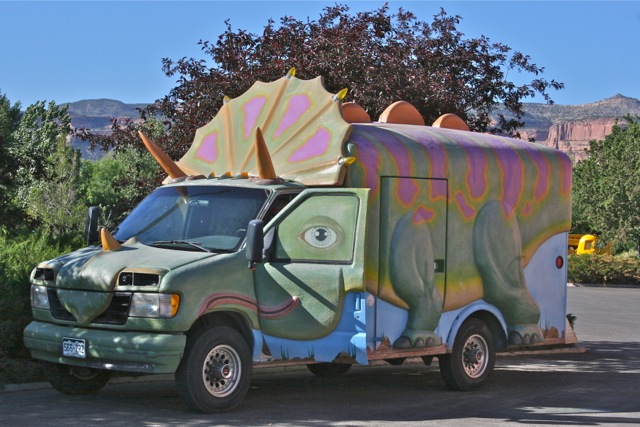



I enjoyed your article on National Parks, the Dino Digs etc, Good job.
Thanks, Dad! You instilled a love of national parks in me and David!!